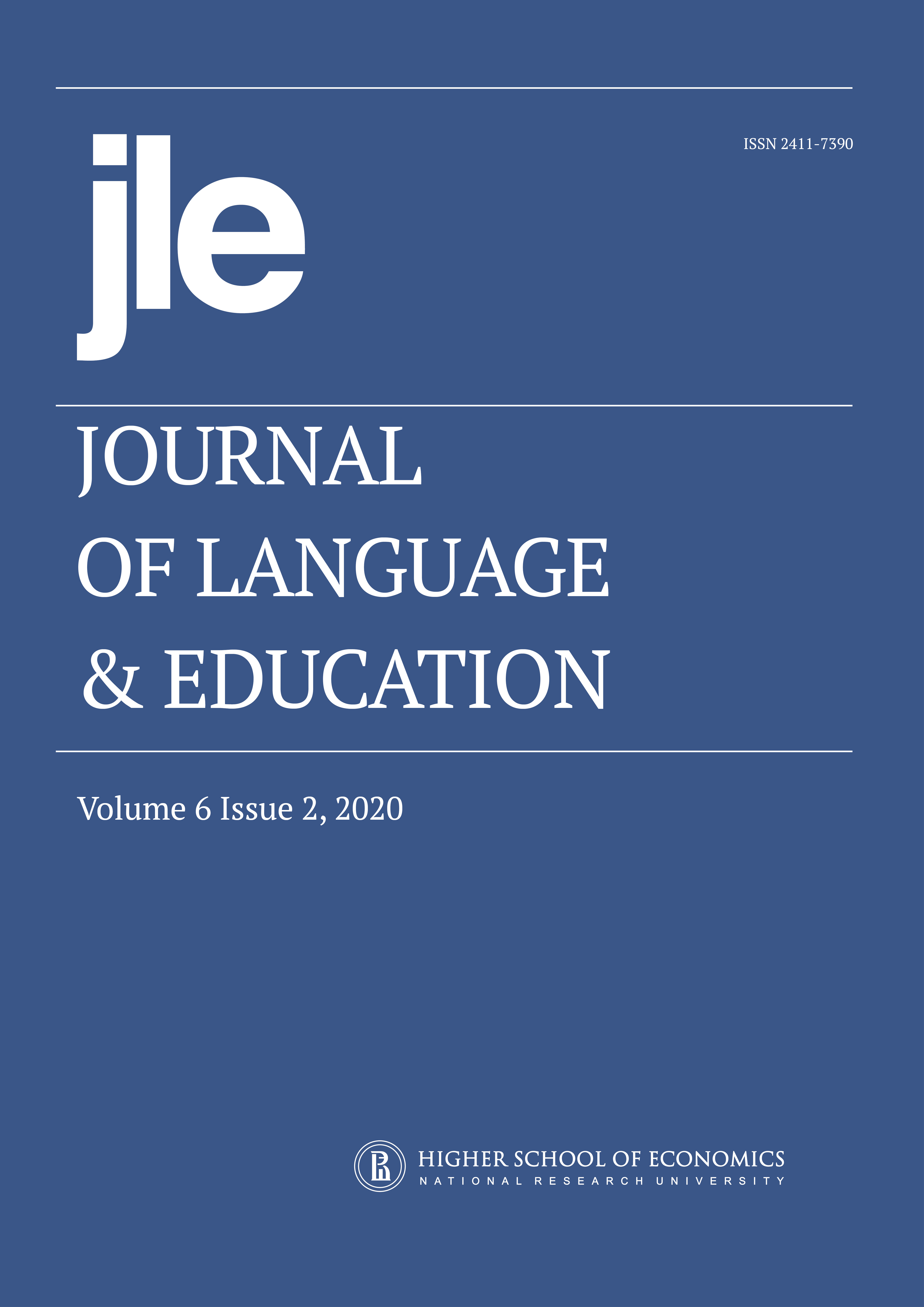The Foreign Language Teaching Anxiety Scale: Preliminary Tests of Validity and Reliability
Abstract
Although anxiety in the foreign language learning context has been studied extensively, the anxiety experienced by foreign language teachers, who are important stakeholders of classroom contexts and language learners themselves, seems to be overlooked. While research mainly focuses on foreign language anxiety in a learning context, there is not sufficient research to contextualize foreign language teaching anxiety (FLTA). In addition, in the current literature, few studies were performed to measure FLTA. In light of this, this study aims to present the preliminary results of the validity and reliability of the Foreign Language Teaching Anxiety Scale (FLTAS). A background questionnaire and the FLTAS were administered to 100 senior pre-service teachers of English as a foreign language (EFL), before performing Cronbach’s Alpha and exploratory factor analysis. The findings showed that the scale obtains a high reliability coefficient and internal consistency in a five-factor solution. The study ends with recommendations for further research.
Downloads
References
Acheson, K., Taylor, J., & Luna, K. (2016). The burnout spiral: The emotion labor of five rural U.S. foreign language teachers. The Modern Language Journal, 100(2), 522-537. DOI: https://doi.org/10.1111/modl.12333
Aydın, S. (2016). A qualitative research on foreign language teaching anxiety. The Qualitative Report, 21(4), 629-642.
Bekleyen, N. (2009). Helping teachers become better English students: Causes, effects, and coping strategies for foreign language listening anxiety. System, 37(4), 664-675. DOI: https://doi.org/10.1016/j.system.2009.09.010
Cowie, N. (2011). Emotions that experienced English as a Foreign Language (EFL) teachers feel about their students, their colleagues and their work. Teaching and Teacher Education, 27(1), 235-242. DOI: https://doi.org/10.1016/j.tate.2010.08.006
DeVellis, R. F. (2016). Scale development: Theory and applications (4th ed.). Sage Publications.
Dewaele, J.-M. (2007). The effect of multilingualism, sociobiographical, and situational factors on communicative anxiety and foreign language anxiety of mature language learners. International Journal of Bilingualism, 11(4), 391-409. DOI: https://doi.org/10.1177/13670069070110040301
Dewaele, J.-M., MacIntyre, P., Boudreau, C., & Dewaele, L. (2016). Do Girls Have All the Fun? Anxiety and Enjoyment in the Foreign Language Classroom. Theory and Practice of Second Language Acquisition, 2(1), 41-63.
Elkhafaifi, H. (2005). Listening comprehension and anxiety in the Arabic language classroom. The Modern Language Journal, 89(2), 206-220. DOI: https://doi.org/10.1111/j.1540-4781.2005.00275.x
Güngör, F., & Yaylı, D. (2012). Self-efficacy and anxiety perceptions of pre-service EFL teachers. In A. Akbarov & V. Cook (Eds.), Self-efficacy and anxiety perceptions of pre-service EFL teachers (pp. 227-236). IBU Publications.
Horwitz, E. K. (1996). Even teachers get the blues: Recognizing and alleviating language teachers' feelings of foreign language anxiety. Foreign Language Annals, 29(3), 365-372. DOI: https://doi.org/10.1111/j.1944-9720.1996.tb01248.x
Horwitz, E. K. (2010). Foreign and second language anxiety. Language Teaching, 43(2), 154-167. DOI: https://doi.org/10.1017/s026144480999036x
Horwitz, E. K., Horwitz, M. B., & Cope, J. (1986). Foreign language classroom anxiety. The Modern Language Journal, 70(2), 125-132. DOI: https://doi.org/10.1111/j.1540-4781.1986.tb05256.x
İpek, H. (٢٠٠٦). Foreign language teaching anxiety (Unpublished doctoral dissertation), Anadolu University.
İpek, H. (٢٠١٦). A qualitative study on foreign language teaching anxiety. Journal of Qualitative Research in Education, 4(3), 1-14. DOI: https://doi.org/10.14689/issn.2148-2624.1.4c3s5m
Kim, S.-Y., & Kim, J. (2004). When the learner becomes a teacher: Foreign language anxiety as an occupational hazard. English Teaching, 59(1), 165-185.
Kongchan, C., & Singhasiri, W. (2008). Teachers' Anxiety about Using L2 in EFL Classrooms. Proceedings of the 16th Annual Korea TESOL International Conference: Responding to a Changing World (p. 145-149). Seoul.
MacIntyre, P. D., & Gardner, R. C. (1994). The subtle effects of language anxiety on cognitive processing in the second language. Language Learning, 44(2), 283-305. DOI: https://doi.org/10.1111/j.1467-1770.1994.tb01103.x
Merç, A. (2010). Foreign language student teacher anxiety (Unpublished doctoral dissertation), Anadolu University.
Merç, Ali. (2011). Sources of foreign language student teacher anxiety: A qualitative inquiry. Turkish Online Journal of Qualitative Inquiry, 2(4), 80-94. DOI: https://doi.org/10.17569/tojqi.08990
Mercer, S. (2018). Psychology for language learning: Spare a thought for the teacher. Language Teaching, 51(4), 504-525. DOI: https://doi.org/10.1017/s0261444817000258
Mercer, S., & Gregersen, T. (2020). Teacher wellbeing. Oxford University Press.
Mercer, S., Oberdorfer, P., & Saleem, M. (2016). Helping language teachers to thrive: Using positive psychology to promote teachers' professional well-being. In D. Gabrys-Barker & D. Galajda (Eds.), Positive Psychology perspectives on foreign language learning and teaching (pp. 213-229). DOI: https://doi.org/10.1007/978-3-319-32954-3_12
Numrich, C. (1996). On becoming a language teacher: Insights from diary studies. TESOL Quarterly, 30(1), 131-153. DOI: https://doi.org/10.2307/3587610
Onwuegbuzie, A. J., Bailey, P., & Daley, C. E. (1999). Factors associated with foreign language anxiety. Applied Psycholinguistics, 20(2), 217-239. DOI: https://doi.org/10.1017/S0142716499002039
Scovel, T. (1978). The effect of affect on foreign language learning: A review of the anxiety research. Language Learning, 28(1), 129-142. DOI: https://doi.org/10.1111/j.1467-1770.1978.tb00309.x
Spielberger, C. D. (1983). Manual for the State-Trait Anxiety Inventory. Consulting Psychologists Press.
Tran, T. T. T., Baldauf, R. B., & Moni, K. (2013). Foreign language anxiety: Understanding its status and insiders' awareness and attitudes. TESOL Quarterly, 47(2), 216-243. DOI: https://doi.org/10.1002/tesq.85
Tüm, D. O. (2012). Feelings of language anxiety amongst non-native student teachers. Procedia - Social and Behavioral Sciences, 47, 2055-2059. DOI: https://doi.org/10.1016/j.sbspro.2012.06.948
Tüm, D. O. (2015). Foreign language anxiety's forgotten study: The case of the anxious preservice teacher. TESOL Quarterly, 49(4), 627-658. DOI: https://doi.org/10.1002/tesq.190
Wieczorek, A. L. (2014). Factors evoking stress among foreign language teachers. Qualitative approach (Unpublished Ph.D. Dissertation). University of Silesia.
Wieczorek, A. L. (2016). High inhibitions and low self-esteem as factors contributing to foreign language teacher stress. In D. Gabrys-Barker & D. Gałajda (Eds.), Positive psychology perspectives on foreign language learning and teaching (pp. 231-248). DOI: https://doi.org/10.1007/978-3-319-32954-3_13
Woodrow, L. (2006). Anxiety and speaking English as a second language. RELC Journal, 37(3), 308-328. DOI: https://doi.org/10.1177/0033688206071315
Yoon, T. (2012). Teaching English though English: Exploring anxiety in non-native pre-service ESL teachers. Theory and Practice in Language Studies, 2(6), 1099-1107. DOI: https://doi.org/10.4304/tpls.2.6.1099-1107
Copyright (c) 2020 National Research University Higher School of Economics

This work is licensed under a Creative Commons Attribution 4.0 International License.
Authors who publish with this journal agree to the Copyright Notice.



